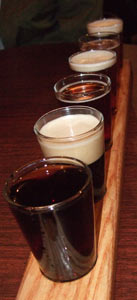SEARCH THIS ISSUE >>> |
 Editor's note about Sam's Notes: Sam is relatively new to great beer, but he got a crash course when he lived in the San Diego area and now he can't go back. Below you'll find some of Sam's ponderings on exploring new tastes and jumpstarting your own fine beer education.
Editor's note about Sam's Notes: Sam is relatively new to great beer, but he got a crash course when he lived in the San Diego area and now he can't go back. Below you'll find some of Sam's ponderings on exploring new tastes and jumpstarting your own fine beer education.
Sam's n00b n0tes
THEY DRINK IT WARM?!…
Anyone want a cold beer? In my early days it seemed this was a common question. We were taught to seek out the coldest beer possible. All the more mysterious was the rumor that Europeans drank their ales warm ... yuck! As time went by, this intrigued me. At exactly what temperature should you drink beer?
Well, I’m not going to tell you that. I invite the editor to post some reference temps. I, however, would like to talk about the fact that you owe it to yourself to investigate drinking at different temperatures.
With most things we don’t usually think about temperature, not exactly. When you order a coffee, do you tell them how hot you want it? You don’t order a steak according the temperature; you say rare, medium rare, etc.. Believe it or not it’s all about temperature. A medium rare steak is around 135 degrees. Too hot and the coffee is still boiling, too cool and the taste will be off. So in a world governed by degrees of temperature, it really does matter.
Most of the mega- breweries use cheaper, less tasteful additives, so having you drink at colder temps helps to mask the not-so-good flavors. At warmer temps you begin to taste more flavors. This is a good thing, unless you’ve used inferior brewing products!
When I first sipped an IPA it was straight out of the liquor store cooler, so most of the hop flavor was muted along with any other flavor that should have been in it. All I could taste was bitterness, and not that good extra-hopped bitters that makes an IPA so wonderful ... it was just bitter! So in my ignorance I decided it should be even colder. What a mistake! I could not figure out why people enjoyed that bitter, sour flavor. But not ready to give up, I thought about how I had learned that across the “big pond” they didn’t drink Irish stouts warm. They simply poured them at cellar temperature, between 50 and 60 degrees, and I so loved to have an ale at this temp. So, I applied this logic to the IPA as well. I’m not sure what the temperature was exactly, but I know it was warmer than the store cooler and wham! -- I found hop bitterness heaven! Basically I allowed the flavors to open up and blossom.
Since my discovery I’ve tried this with other beverages as well. A craft made root beer has so much to offer, but again if it’s frozen the flavors will be frozen too. As you think about your brew, think about physics. When something is cold it is numb and tasteless, and it instantly numbs your taste buds as well.
Here’s the thing: take out your “cold one” and have a sip, note the flavors or the lack thereof. Let it warm up a bit and taste again. If the flavor gets skunky as it warms then chances are you have a brew made with low quality ingredients. Of course, everyone has different tastes so this is not a hard and fast rule, just a guideline. Don’t be afraid to try the warmer temperatures, you might discover a whole new world!
--Sam Hanssard
Editors note: While I'm not going to lay down hard and fast rules as to beer storage, I will agree with what Sam has found to be true. You taste more at higher temperatures. That being said, it's important to remember that a beer that's warmer than called for will often be less enjoyable. Keep in mind that Ales are brewed at higher temperatures (most styles 65-72° F) and Lagers at lower temperatures (usually 40-60° F). So doesn't it make sense that there should be a gap of similar range in serving temperatures? What I like to do is start a strong dark ale at about 50 degrees F and slowly let it warm up, so I get the refreshment but I also get to know the nuances of the beer over time. With a light lager, I might start as low as 37° (I won't usually go quite that low) and not usually let it warm up beyond 52°.